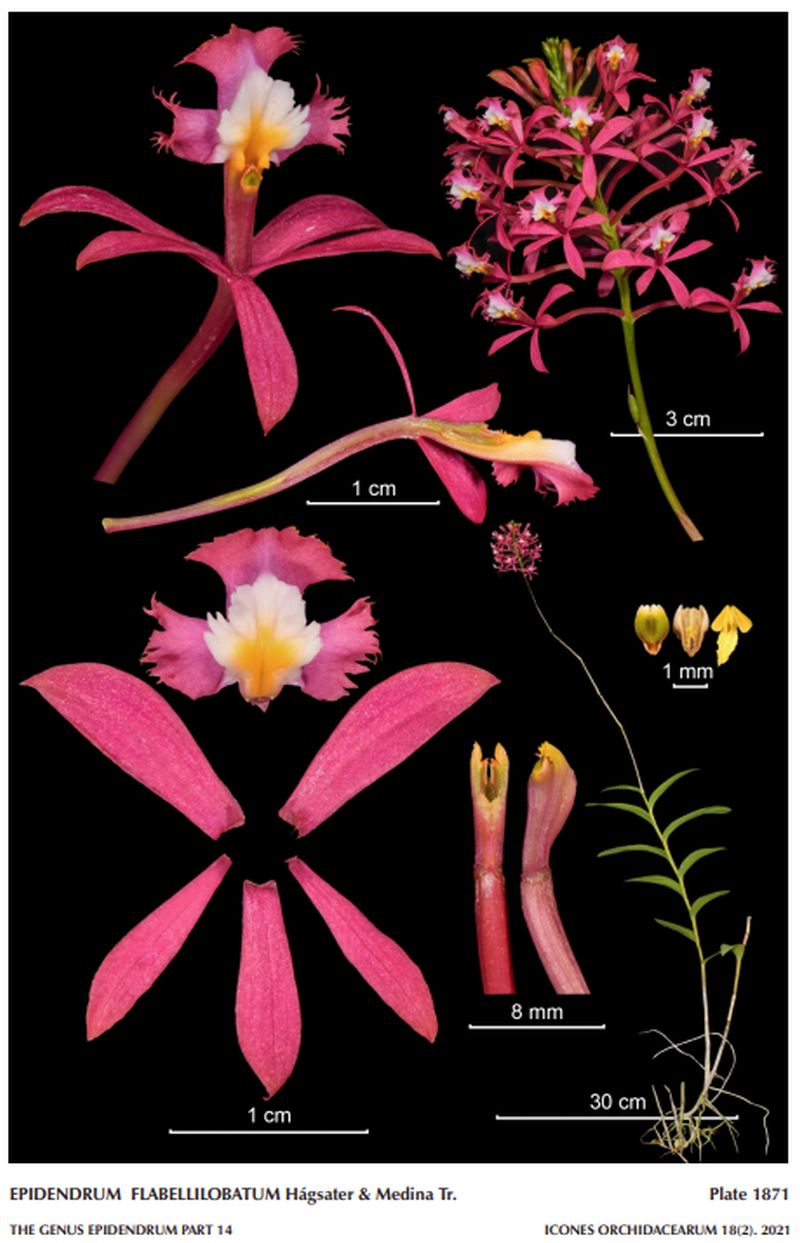

Epidendrum flabellilobatum Hagsater & Medina Tr.2021 GROUP Secundum SUBGROUP Secundum
LCDP Photo by © R Jimenez M. & A. Cisneros Icones Orchidacearum 18(2) Plate 1871 Hagsater & Jimenez 2021






Common Name The Fan-Shaped Lobe Epidendrum [refers to the mid lobe of the lip]
Flower Size .8" [2 cm]
Found in Santander, Cundinamarca, Tolima, Huila, and Putumayo departments of Colombia at elevations around 1700 to 2450 meters as a medium to giant sized, cool growing terrestrial or epiphyte with simple, cane-like, terete, and somewhat laterally compressed towards the apex, thin stems with basal half covered by non-foliar sheaths and carrying 4 to 9, distichous, distributed throughout the apical half of the stem, sheaths tubular, smooth, papyraceous and scarious when dry, blade elliptic-lanceolate, articulate, apex narrowly rounded, unequally bilobed, coriaceous, smooth, medium green, margins entire leaves that blooms in the fall, winter and spring on a terminal, without a spathe, peduncle [33 to 45 cm] long, elongate, straight, provided with ca. 7, tubular, imbricate, acuminate, yellow with brown dots bracts, rachis 2.4 to 3.6" [6 to 9 cm] long, racemose to pluri-racemose, producing new racemes from the subapical nodes of the peduncle, 16.8" to 20" [42 to 50 cm] long, successively to 35, about 40 flowered inflorescnece with , decreasing in size, much shorter than the ovary, narrowly triangular, acuminate, embracing floral bracts and carrying non-resupinate, non-fragrant flowers.
"Epidendrum flabellilobatum belongs to the GROUP Secundum SUBGROUP Secundum, which is recognized by the caespitose habit, simple stems, leaves oblong-lanceolate, coriaceous, bilobed, the elongate peduncle of the erect, pluri-racemose inflorescence, the flowers non-resupinate, and the callus complicated, pluri-tuberculate. The new species has flowers pink-red, or Mexican pink, the lip somewhat paler towards the center, callus white, deep yellow at the junction with the apex of the column which is dark wine-red, the apical margins deep yellow petals .5" x .112" [12.5 x 2.8 mm], elliptic-oblanceolate, narrow, and the lobes of the lip do not overlap, the mid-lobe is .2 x .328" [5.0 x 8.2 mm], flabelliform, apex more or less shallowly emarginate, more or less bi-lobate. Epidendrum tulcanense has orange-red to deep red flowers including the column, and the massive callus is white, sepals .52" [13 mm] long, and the petals .52 x .16 to .24" [13 x 4 to 6 mm], widely oblanceolate sub-spatulate. Epidendrum holstii Hágsater & Carnevali has crimson red to salmon or coral-red sepals and petals, and a pink to purple lip, and the wide lip mid-lobe usually overlaps with the lateral lobes, the margin spreading, the callus massive, yellow, the edges white; the flowers are relatively small, sepals .32 to .52" [8 to 13 mm] long. Epidendrum acutilobum Hágsater & Uribe-Velez has coral-red to lilac flowers, with a large white callus on the lip, sepals .8 x .192 to .2" [20 x 4.8 to 5.0 mm], oblanceolate, petals .76" [19 mm] long, elliptic-lanceolate, the lip has a massive callus, formed by 3 unequal tubercules, with a pair of digital, bilobed calli on the sides and the main central body truncate to acute, reaching the middle of the mid-lobe, margin crenate, and the mid-lobe has an entire margin. Epidendrum villahermosaense Sierra-Ariza & Hágsater, from the Cordillera Central in Tolima, has similar colored flowers, but the flowers larger, sepals .72 to .88" [18 to 22 mm] long, and the lip has the retrorse lateral lobes deeply lacerate, spreading with the lateral margins entire and strongly revolute, the mid-lobe “Y” shaped, narrow at the base, and spreading towards the apex, with the lateral margins strongly revolute, NOTE: The size of the plants depends on the exposure to direct sunlight. Epiphytic in trees the stems are very long, often horizontal in search of sun-light. When growing on rocky road banks the plants are short when they are early colonizers and become taller as other bushes start to compete for sunlight, the leafy stem growing until it is in full sunlight and the producing the elongate inflorescence so that the flowers are clearly visible above the surrounding vegetation." Hagsater etal 2021
Synonyms
References W3 Tropicos, Kew Monocot list , IPNI ; * Icones Orchidacearum 18(2) Plate 1871 Hagsater & Jimenez 2021 LCDP Photo/photo fide; Icones Orchidacearum 18(2) Plate 1897 Hagsater & Jimenez 2021 see recognition section
--------------------------------------------------------------------------------------------------------------------------